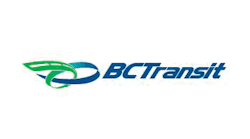BC Transit launches Umo contactless payment system on Victoria Regional Transit
BC Transit has launched the Umo contactless payment method and new fare products on Victoria Regional Transit. Umo is owned and operated by Cubic Transportation Systems (CTS).
New payment methods include the Umo Mobility app and a reloadable Umo card. The Umo Mobility app is available for free in the Apple App and Google Play stores. Once downloaded, riders create an account to purchase and manage their fare products. When ready to travel, riders open their app to display a dynamic QR code that serves as their fare product. As riders board the bus, they present their app’s QR code to a new onboard digital validator.
The Umo app also provides riders with additional tools to help them plan their trip, including real-time information and maps. Riders can also use the app to create alerts that will inform them when they are nearing their stop while travelling and if their fare product is running low on funds or nearing its expiration date.
"We are thrilled to introduce Umo to the residents of Victoria and soon to the other systems within BC Transit,” said Bonnie Crawford, VP and GM, CTS. “With a rich 20-year history in British Columbia through our partnership with TransLink in Vancouver, Cubic is excited to enable equitable and simplified access to public transit with Umo to British Columbians. With Umo, riders throughout the province will be able to more seamlessly connect to their jobs, schools and the people and places they love most.”
Riders also have the choice of using a reloadable Umo card. A Umo card can be picked up for free from a BC Transit vendor. The card is designed for continued use and can be continually topped up with fare products through a vendor, online or through Umo’s customer service call center. When ready to travel, riders will tap their card at the new onboard validator.
At a future date, BC Transit plans to provincially enable onboard payments with debit and credit cards. These additional payment methods will provide wider access to transit perfect for riders who utilize transit services occasionally. Both debit and credit cards will benefit from the same fare-capping policy mobile app and reloadable card riders receive.
Umo’s arrival introduces changes and improvements to some of the fares riders use with the introduction of the 30-Day Pass and Cash Balance fare products. The 30-Day Pass, eventually replacing the existing Monthly Pass, provides riders with the same convenience of having an unlimited long-term fare product, but introduces the flexibility of not having to wait until the start of a calendar month to use it. Cash Balance, eventually replacing paper tickets, is a stored dollar amount a rider draws from as additional trips are taken.
The popular DayPASS fare product also sees improvements, with Umo’s arrival through an increase in the number of ways riders can access it and by lowering a rider’s commitment to purchasing it. Riders paying with a Cash Balance fare product will have their fare capped and automatically converted to a DayPASS after payment on their second trip of the day. A rider will know a DayPASS has been applied to their payment method by referencing a confirmation message on the onboard validator’s digital screen.
Riders who are part of a specialty fare program, such as a U-Pass or ProPass program, will also benefit as a result of Umo’s new payment methods. Program riders will find significant time savings using Umo’s convenient method to link their transit pass to their choice of new payment methods now in place compared to the previous in-person processes. Riders will now be sent a unique benefit code from their program administrator and redeem it inside the mobile app, online or through Umo’s customer service call center.
In the months following Umo’s launch in the Victoria Regional Transit System, Umo is scheduled to be implemented in 29 other transit systems. BC Transit’s Electronic Fare Collection System Project to implement Umo is funded through the Investing in Canada Infrastructure Program. The project is cost-shared, with the government of Canada contributing 50 percent of eligible costs, the Province of British Columbia contributing 40 percent and the project’s local government partners contributing the remaining 10 percent. The total cost for the project in 30 transit systems is C$23.2 million (US$17 million).
BC Transit plans to provide riders several months to transition to a new Umo payment method. While it is expected most riders will find one of Umo’s new payment methods a more convenient option, cash will continue to be accepted for those riders who prefer to use it.
"I am so excited to take this giant leap towards achieving our goal of making BC Transit your best transportation solution,” said Christy Ridout, vice president of strategy and public affairs at BC Transit. “We listened to our riders' requests for a new payment method, and we are delighted to introduce the innovative Umo solution.”

Brandon Lewis | Associate Editor
Brandon Lewis is a recent graduate of Kent State University with a bachelor’s degree in journalism. Lewis is a former freelance editorial assistant at Vehicle Service Pros in Endeavor Business Media’s Vehicle Repair Group. Lewis brings his knowledge of web managing, copyediting and SEO practices to Mass Transit Magazine as an associate editor. He is also a co-host of the Infrastructure Technology Podcast.



